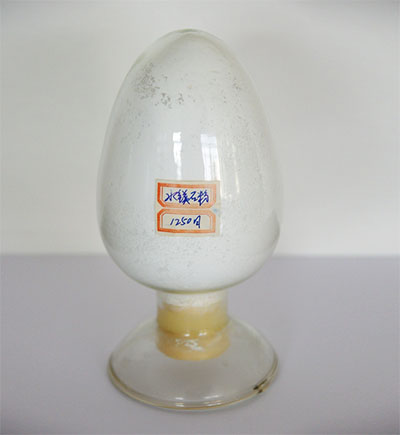When the magnesia carbon brick is in contact with the molten steel and the slag, the slag erodes the magnesia carbon brick, and the high-purity magnesia brick causes the thermal shock stability of the magnesia carbon brick to be poor, the peeling damage occurs, the service life of the slag magnesia carbon brick is shortened, and the LF furnace refining is affected. produce. In order to prolong the service life of magnesia carbon bricks, the researchers studied the effect of LF furnace slag on the corrosion resistance of magnesia carbon bricks, and discussed the ways to extend the life of magnesia carbon bricks for LF slag lines.
Experimental materials and processes
The experiment uses low-iron slag and high-iron slag for LF furnace, the composition of which is shown in the attached table. Magnesia carbon bricks use the slag-line magnesia carbon brick MT-14 currently used in Angang.
After the slag-line magnesia carbon brick was made into a crucible sample with an inner diameter of ф60 mm×50 mm and an outer diameter of ф120 mm×100 mm, the LF low-iron slag and high-iron slag were separately charged into the prepared crucible, and kept at 1600 ° C for 3 h. The anti-slag erosion test of magnesia carbon brick was carried out by static enthalpy method. They grind two kinds of LF furnace slag into 200 mesh fine powder, press the thermoplastic phenolic resin as a binder, press it into a cylindrical sample of ф6mm×5mm, put it on the gasket made of slag magnesia carbon brick, and put it on it. It is placed in the refractoriness tester DRH-III to observe the wetting angle of the slag and the magnesia carbon brick when the sample reaches the hemispherical temperature, thereby characterizing the wetting property of the slag to the magnesia carbon brick.

Wetting angle detection. According to the wetting angle of the two slag ash furnaces on the magnesia carbon bricks, the researchers calculated that the LF slag with less iron has a wetting angle of 45° to the magnesia carbon bricks, and the iron LF slag has a moisturizing effect on the magnesia carbon bricks. The wet angle is 58°. It can be seen that both slags of the LF furnace can wet the magnesia carbon bricks, and the slag wetting phenomenon with less iron is more obvious, and the erosion of the bricks is more obvious. Therefore, the slag composition of the LF furnace can be adjusted within a certain range, and the wetting angle of the slag to the product is increased, thereby improving the corrosion resistance of the magnesia carbon brick.
Resistance to slag erosion analysis. The SEM topography of the LF slag of iron and iron and the slag of the magnesia carbon brick shows that after being eroded by the LF slag, a thin slag layer is formed on the surface of the magnesia carbon brick, and the sample with less iron is hung. The slag layer is relatively obvious. Due to the short erosion time, the erosion layer on the surface of the magnesia carbon brick is thinner after being eroded by the two kinds of slag. At the same time, the flaky graphite on the surface of the magnesia carbon brick in contact with the slag is oxidized, and the matrix is loose. Moreover, the erosion of magnesia carbon bricks by low-iron LF slag is significantly stronger than that of high-iron LF slag, and the erosion layer is relatively deep. This is because the wetting angle of the low iron slag to the magnesia carbon brick is relatively small, and the wetting rate of the magnesia carbon brick is fast under the same conditions, thereby accelerating the erosion of the magnesia carbon brick.
The researchers further found that the LF slag first wets the surface of the magnesia carbon brick, and then invades the matrix of the magnesia carbon brick along the pores left by the oxidation of the graphite, filling around the magnesia particles, and chemically etching the magnesia particles. A low-melting liquid phase containing Ca, Si, and Al is formed to gradually encroach on the magnesia particles. It can be inferred that as the reaction time is prolonged, a cementation structure will be formed in the magnesia carbon brick, and the magnesia particles will be embedded in the liquid phase, and the corners of the magnesia particles will be eroded by the slag and become smooth, thereby making the magnesium carbon The composition and properties of the erosion layer and the original brick layer of the brick, especially the coefficient of thermal expansion, are very different. When subjected to thermal shock and thermal shock during use, the working surface of the magnesia carbon brick will be peeled off and damaged. Under the condition of refining outside the LF furnace, the viscosity of the slag is lowered due to the high refining temperature, and the inside of the lining is added. The temperature is also high, and the slag can penetrate into the deeper part of the refractory material to form a thicker reaction layer, which will aggravate the melting loss of the magnesia carbon brick lining and cause severe peeling and chip damage. Therefore, the influence of LF slag on magnesia carbon bricks is mainly manifested by chemical erosion and the resulting thermal shock stability, resulting in spalling damage.
Ways to extend the life of magnesia carbon bricks for slag lines
In summary, the wetting angle of the two LF furnace slags to the magnesia carbon bricks is less than 90°, which is easy to wet the surface of the magnesia carbon bricks, and will accelerate the damage rate of the magnesia carbon bricks when in contact with the magnesia carbon bricks, and the low iron The wetting phenomenon of LF slag is more obvious. In the erosion test, this phenomenon reduces the erosion resistance of the magnesia carbon bricks in contact with the low iron slag.
In order to prolong the slag corrosion life of LF furnace magnesia carbon bricks, the composition of slag can be adjusted, and the wetting angle of slag to magnesia carbon brick can be increased to form a stable slag layer on the surface of magnesia carbon brick to prevent surface graphite. Oxidation, inhibiting the wetting of the surface of the magnesia carbon brick by the slag, or optimizing the matrix structure of the magnesia carbon brick, improving the introduction form and amount of graphite in the magnesia carbon brick, adjusting the composition of the matrix, thereby affecting the magnesia carbon brick The service life of the LF slag line magnesia carbon bricks is prolonged by the number, size, shape and distribution of the pores formed by carbon oxidation during use.
tel:+86-0412-7823890 Mobile phone:+86-13804925659![]()
![]()
![]()
![]()
![]()
![]()
![]()
![]()
![]()
![]()
![]()
fax:0412-7821123 email:lnhyky@126.com
Address: 16-1, the fourth phase of the Jade Pearl of Silk Road, Xiuyan County, Anshan City, Liaoning Province

Sweep, learn more +